Strategic Management Report: Ryanair's Strategy and Recommendations
VerifiedAdded on 2021/01/02
|10
|3078
|43
Report
AI Summary
This report provides a comprehensive strategic management analysis of Ryanair, a low-cost airline. It begins with background information and an overview of the airline industry, followed by a detailed PESTLE analysis examining political, economic, social, technological, legal, and environmental factors impacting Ryanair. The report then utilizes Porter's Five Forces to assess competitive dynamics, including customer and supplier bargaining power, the threat of substitutes and new entrants, and existing competition. An internal analysis using the VRIO framework evaluates Ryanair's strategic capabilities, including its valuable, rare, imitable, and organizable resources. The report explores strategic direction options, such as market penetration, market development, product development, and diversification, and concludes with strategy selection, justification, and recommendations for future success.
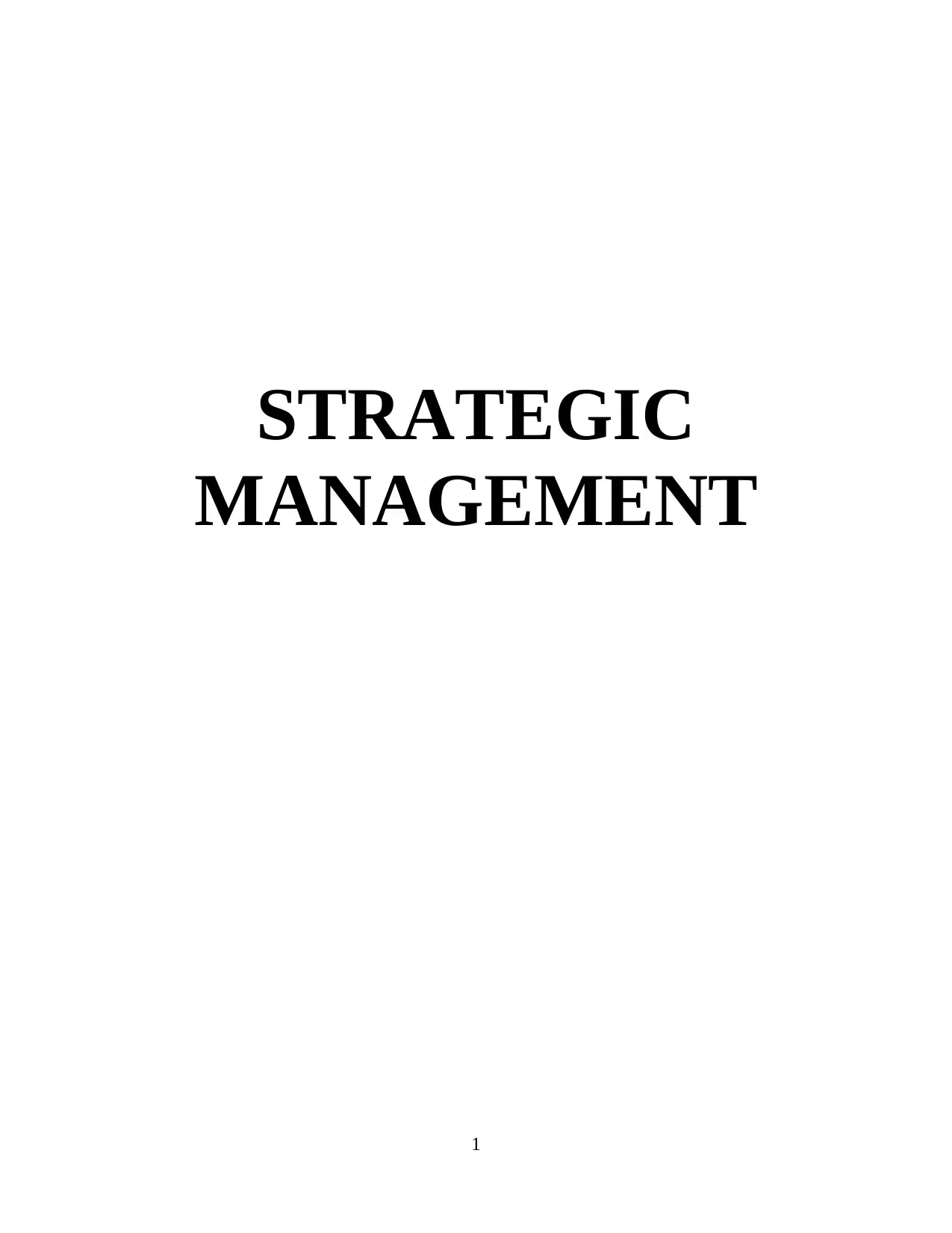
STRATEGIC
MANAGEMENT
1
MANAGEMENT
1
Paraphrase This Document
Need a fresh take? Get an instant paraphrase of this document with our AI Paraphraser
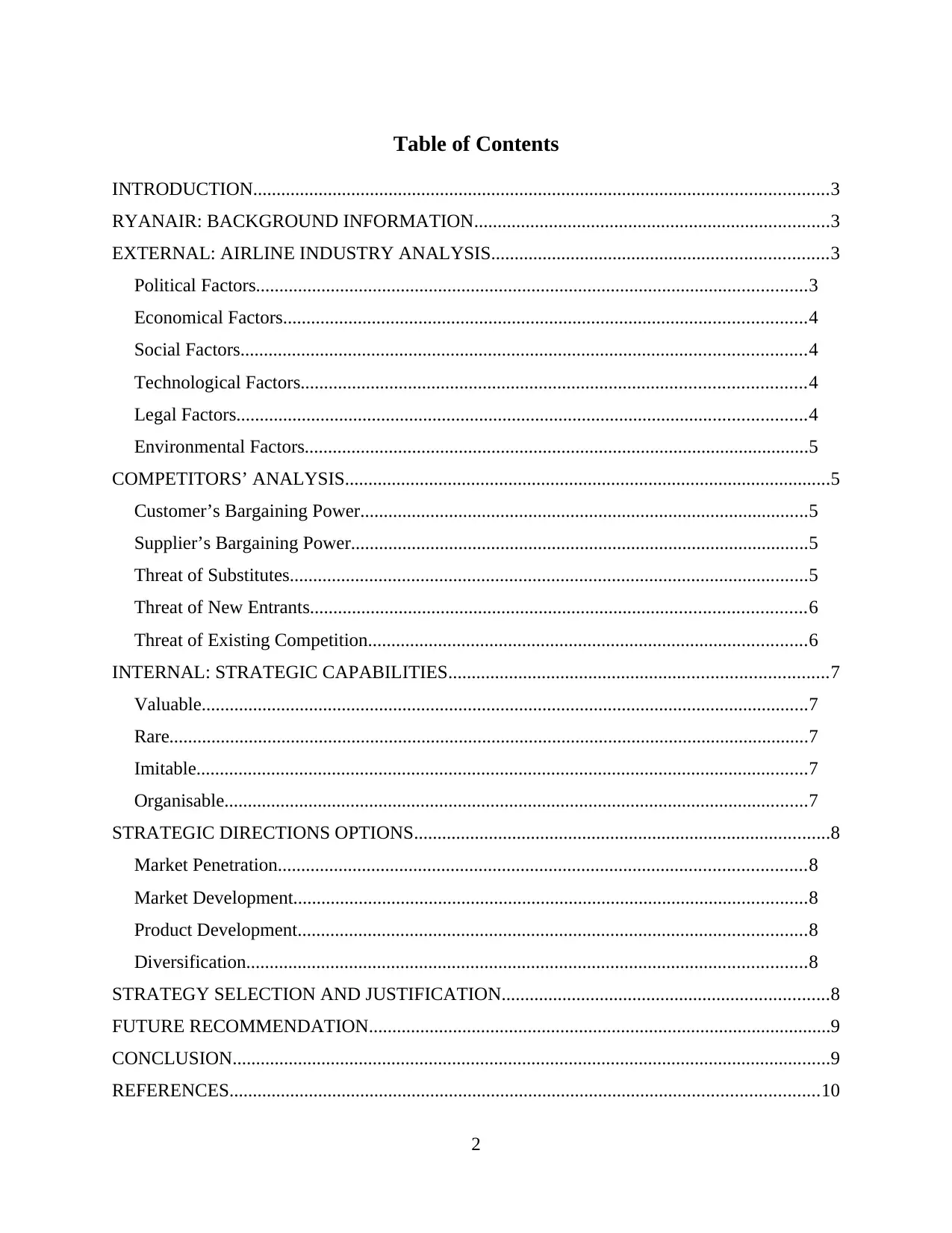
Table of Contents
INTRODUCTION...........................................................................................................................3
RYANAIR: BACKGROUND INFORMATION............................................................................3
EXTERNAL: AIRLINE INDUSTRY ANALYSIS........................................................................3
Political Factors......................................................................................................................3
Economical Factors................................................................................................................4
Social Factors.........................................................................................................................4
Technological Factors............................................................................................................4
Legal Factors..........................................................................................................................4
Environmental Factors............................................................................................................5
COMPETITORS’ ANALYSIS........................................................................................................5
Customer’s Bargaining Power................................................................................................5
Supplier’s Bargaining Power..................................................................................................5
Threat of Substitutes...............................................................................................................5
Threat of New Entrants..........................................................................................................6
Threat of Existing Competition..............................................................................................6
INTERNAL: STRATEGIC CAPABILITIES.................................................................................7
Valuable..................................................................................................................................7
Rare.........................................................................................................................................7
Imitable...................................................................................................................................7
Organisable.............................................................................................................................7
STRATEGIC DIRECTIONS OPTIONS.........................................................................................8
Market Penetration.................................................................................................................8
Market Development..............................................................................................................8
Product Development.............................................................................................................8
Diversification........................................................................................................................8
STRATEGY SELECTION AND JUSTIFICATION......................................................................8
FUTURE RECOMMENDATION...................................................................................................9
CONCLUSION................................................................................................................................9
REFERENCES..............................................................................................................................10
2
INTRODUCTION...........................................................................................................................3
RYANAIR: BACKGROUND INFORMATION............................................................................3
EXTERNAL: AIRLINE INDUSTRY ANALYSIS........................................................................3
Political Factors......................................................................................................................3
Economical Factors................................................................................................................4
Social Factors.........................................................................................................................4
Technological Factors............................................................................................................4
Legal Factors..........................................................................................................................4
Environmental Factors............................................................................................................5
COMPETITORS’ ANALYSIS........................................................................................................5
Customer’s Bargaining Power................................................................................................5
Supplier’s Bargaining Power..................................................................................................5
Threat of Substitutes...............................................................................................................5
Threat of New Entrants..........................................................................................................6
Threat of Existing Competition..............................................................................................6
INTERNAL: STRATEGIC CAPABILITIES.................................................................................7
Valuable..................................................................................................................................7
Rare.........................................................................................................................................7
Imitable...................................................................................................................................7
Organisable.............................................................................................................................7
STRATEGIC DIRECTIONS OPTIONS.........................................................................................8
Market Penetration.................................................................................................................8
Market Development..............................................................................................................8
Product Development.............................................................................................................8
Diversification........................................................................................................................8
STRATEGY SELECTION AND JUSTIFICATION......................................................................8
FUTURE RECOMMENDATION...................................................................................................9
CONCLUSION................................................................................................................................9
REFERENCES..............................................................................................................................10
2
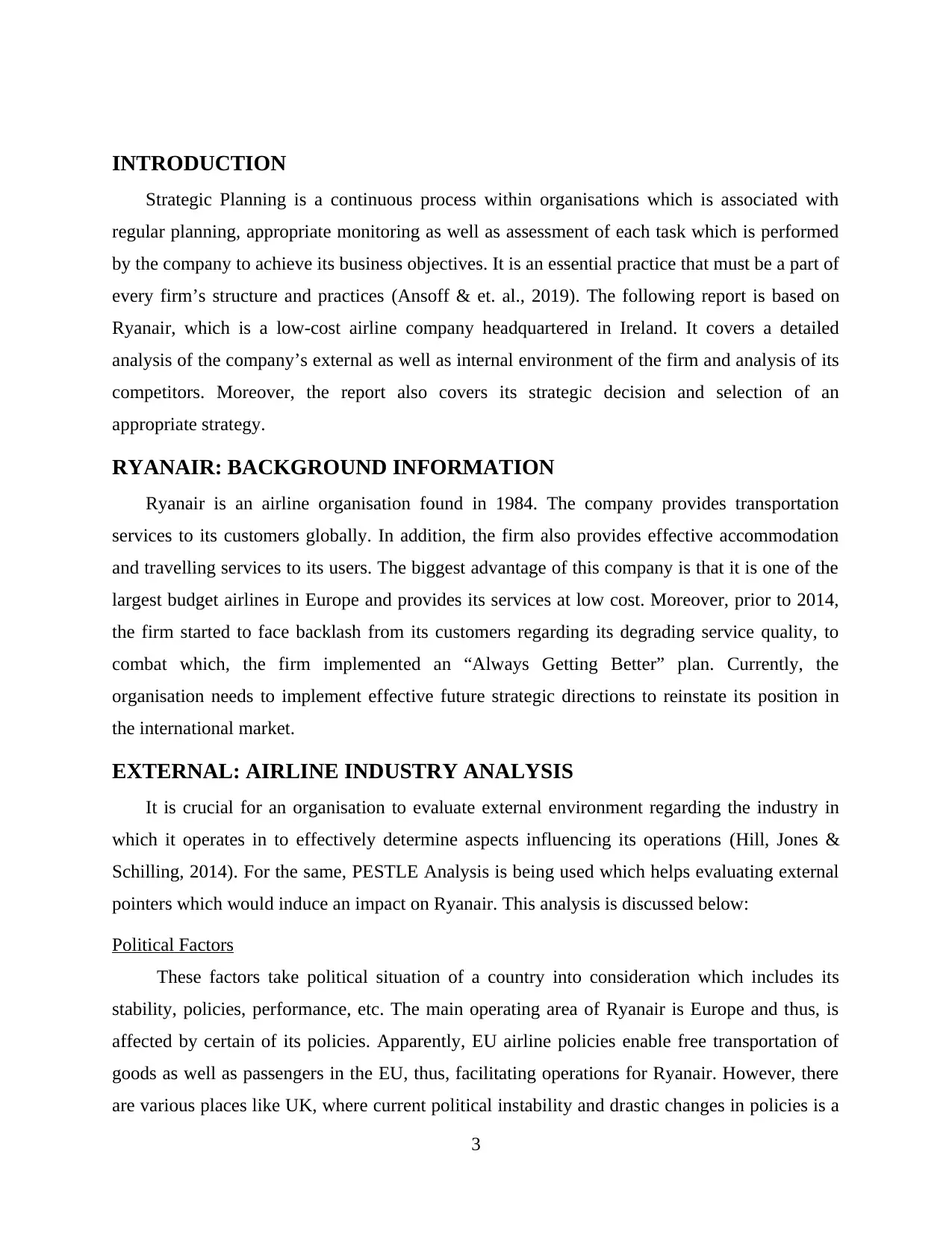
INTRODUCTION
Strategic Planning is a continuous process within organisations which is associated with
regular planning, appropriate monitoring as well as assessment of each task which is performed
by the company to achieve its business objectives. It is an essential practice that must be a part of
every firm’s structure and practices (Ansoff & et. al., 2019). The following report is based on
Ryanair, which is a low-cost airline company headquartered in Ireland. It covers a detailed
analysis of the company’s external as well as internal environment of the firm and analysis of its
competitors. Moreover, the report also covers its strategic decision and selection of an
appropriate strategy.
RYANAIR: BACKGROUND INFORMATION
Ryanair is an airline organisation found in 1984. The company provides transportation
services to its customers globally. In addition, the firm also provides effective accommodation
and travelling services to its users. The biggest advantage of this company is that it is one of the
largest budget airlines in Europe and provides its services at low cost. Moreover, prior to 2014,
the firm started to face backlash from its customers regarding its degrading service quality, to
combat which, the firm implemented an “Always Getting Better” plan. Currently, the
organisation needs to implement effective future strategic directions to reinstate its position in
the international market.
EXTERNAL: AIRLINE INDUSTRY ANALYSIS
It is crucial for an organisation to evaluate external environment regarding the industry in
which it operates in to effectively determine aspects influencing its operations (Hill, Jones &
Schilling, 2014). For the same, PESTLE Analysis is being used which helps evaluating external
pointers which would induce an impact on Ryanair. This analysis is discussed below:
Political Factors
These factors take political situation of a country into consideration which includes its
stability, policies, performance, etc. The main operating area of Ryanair is Europe and thus, is
affected by certain of its policies. Apparently, EU airline policies enable free transportation of
goods as well as passengers in the EU, thus, facilitating operations for Ryanair. However, there
are various places like UK, where current political instability and drastic changes in policies is a
3
Strategic Planning is a continuous process within organisations which is associated with
regular planning, appropriate monitoring as well as assessment of each task which is performed
by the company to achieve its business objectives. It is an essential practice that must be a part of
every firm’s structure and practices (Ansoff & et. al., 2019). The following report is based on
Ryanair, which is a low-cost airline company headquartered in Ireland. It covers a detailed
analysis of the company’s external as well as internal environment of the firm and analysis of its
competitors. Moreover, the report also covers its strategic decision and selection of an
appropriate strategy.
RYANAIR: BACKGROUND INFORMATION
Ryanair is an airline organisation found in 1984. The company provides transportation
services to its customers globally. In addition, the firm also provides effective accommodation
and travelling services to its users. The biggest advantage of this company is that it is one of the
largest budget airlines in Europe and provides its services at low cost. Moreover, prior to 2014,
the firm started to face backlash from its customers regarding its degrading service quality, to
combat which, the firm implemented an “Always Getting Better” plan. Currently, the
organisation needs to implement effective future strategic directions to reinstate its position in
the international market.
EXTERNAL: AIRLINE INDUSTRY ANALYSIS
It is crucial for an organisation to evaluate external environment regarding the industry in
which it operates in to effectively determine aspects influencing its operations (Hill, Jones &
Schilling, 2014). For the same, PESTLE Analysis is being used which helps evaluating external
pointers which would induce an impact on Ryanair. This analysis is discussed below:
Political Factors
These factors take political situation of a country into consideration which includes its
stability, policies, performance, etc. The main operating area of Ryanair is Europe and thus, is
affected by certain of its policies. Apparently, EU airline policies enable free transportation of
goods as well as passengers in the EU, thus, facilitating operations for Ryanair. However, there
are various places like UK, where current political instability and drastic changes in policies is a
3
⊘ This is a preview!⊘
Do you want full access?
Subscribe today to unlock all pages.

Trusted by 1+ million students worldwide
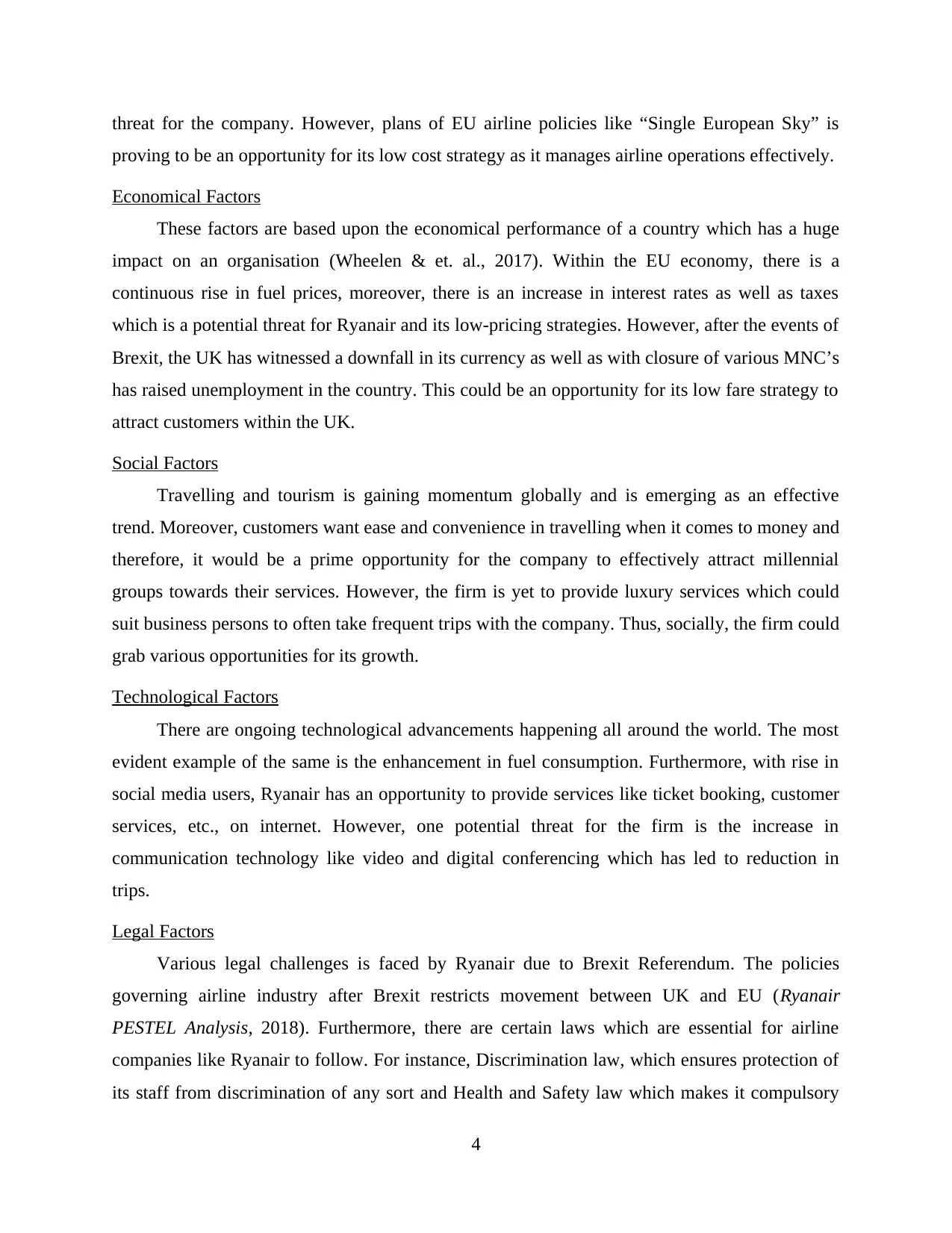
threat for the company. However, plans of EU airline policies like “Single European Sky” is
proving to be an opportunity for its low cost strategy as it manages airline operations effectively.
Economical Factors
These factors are based upon the economical performance of a country which has a huge
impact on an organisation (Wheelen & et. al., 2017). Within the EU economy, there is a
continuous rise in fuel prices, moreover, there is an increase in interest rates as well as taxes
which is a potential threat for Ryanair and its low-pricing strategies. However, after the events of
Brexit, the UK has witnessed a downfall in its currency as well as with closure of various MNC’s
has raised unemployment in the country. This could be an opportunity for its low fare strategy to
attract customers within the UK.
Social Factors
Travelling and tourism is gaining momentum globally and is emerging as an effective
trend. Moreover, customers want ease and convenience in travelling when it comes to money and
therefore, it would be a prime opportunity for the company to effectively attract millennial
groups towards their services. However, the firm is yet to provide luxury services which could
suit business persons to often take frequent trips with the company. Thus, socially, the firm could
grab various opportunities for its growth.
Technological Factors
There are ongoing technological advancements happening all around the world. The most
evident example of the same is the enhancement in fuel consumption. Furthermore, with rise in
social media users, Ryanair has an opportunity to provide services like ticket booking, customer
services, etc., on internet. However, one potential threat for the firm is the increase in
communication technology like video and digital conferencing which has led to reduction in
trips.
Legal Factors
Various legal challenges is faced by Ryanair due to Brexit Referendum. The policies
governing airline industry after Brexit restricts movement between UK and EU (Ryanair
PESTEL Analysis, 2018). Furthermore, there are certain laws which are essential for airline
companies like Ryanair to follow. For instance, Discrimination law, which ensures protection of
its staff from discrimination of any sort and Health and Safety law which makes it compulsory
4
proving to be an opportunity for its low cost strategy as it manages airline operations effectively.
Economical Factors
These factors are based upon the economical performance of a country which has a huge
impact on an organisation (Wheelen & et. al., 2017). Within the EU economy, there is a
continuous rise in fuel prices, moreover, there is an increase in interest rates as well as taxes
which is a potential threat for Ryanair and its low-pricing strategies. However, after the events of
Brexit, the UK has witnessed a downfall in its currency as well as with closure of various MNC’s
has raised unemployment in the country. This could be an opportunity for its low fare strategy to
attract customers within the UK.
Social Factors
Travelling and tourism is gaining momentum globally and is emerging as an effective
trend. Moreover, customers want ease and convenience in travelling when it comes to money and
therefore, it would be a prime opportunity for the company to effectively attract millennial
groups towards their services. However, the firm is yet to provide luxury services which could
suit business persons to often take frequent trips with the company. Thus, socially, the firm could
grab various opportunities for its growth.
Technological Factors
There are ongoing technological advancements happening all around the world. The most
evident example of the same is the enhancement in fuel consumption. Furthermore, with rise in
social media users, Ryanair has an opportunity to provide services like ticket booking, customer
services, etc., on internet. However, one potential threat for the firm is the increase in
communication technology like video and digital conferencing which has led to reduction in
trips.
Legal Factors
Various legal challenges is faced by Ryanair due to Brexit Referendum. The policies
governing airline industry after Brexit restricts movement between UK and EU (Ryanair
PESTEL Analysis, 2018). Furthermore, there are certain laws which are essential for airline
companies like Ryanair to follow. For instance, Discrimination law, which ensures protection of
its staff from discrimination of any sort and Health and Safety law which makes it compulsory
4
Paraphrase This Document
Need a fresh take? Get an instant paraphrase of this document with our AI Paraphraser
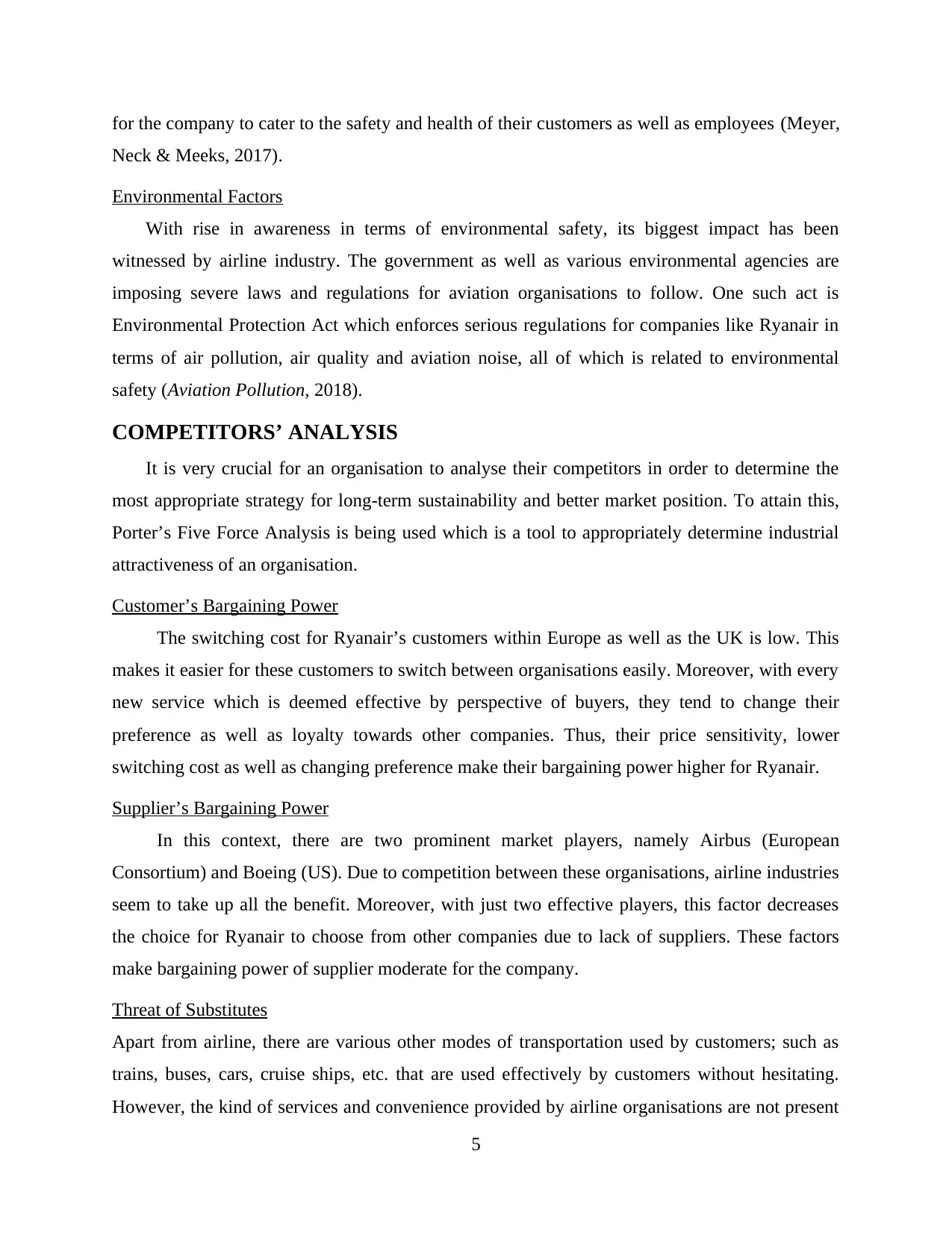
for the company to cater to the safety and health of their customers as well as employees (Meyer,
Neck & Meeks, 2017).
Environmental Factors
With rise in awareness in terms of environmental safety, its biggest impact has been
witnessed by airline industry. The government as well as various environmental agencies are
imposing severe laws and regulations for aviation organisations to follow. One such act is
Environmental Protection Act which enforces serious regulations for companies like Ryanair in
terms of air pollution, air quality and aviation noise, all of which is related to environmental
safety (Aviation Pollution, 2018).
COMPETITORS’ ANALYSIS
It is very crucial for an organisation to analyse their competitors in order to determine the
most appropriate strategy for long-term sustainability and better market position. To attain this,
Porter’s Five Force Analysis is being used which is a tool to appropriately determine industrial
attractiveness of an organisation.
Customer’s Bargaining Power
The switching cost for Ryanair’s customers within Europe as well as the UK is low. This
makes it easier for these customers to switch between organisations easily. Moreover, with every
new service which is deemed effective by perspective of buyers, they tend to change their
preference as well as loyalty towards other companies. Thus, their price sensitivity, lower
switching cost as well as changing preference make their bargaining power higher for Ryanair.
Supplier’s Bargaining Power
In this context, there are two prominent market players, namely Airbus (European
Consortium) and Boeing (US). Due to competition between these organisations, airline industries
seem to take up all the benefit. Moreover, with just two effective players, this factor decreases
the choice for Ryanair to choose from other companies due to lack of suppliers. These factors
make bargaining power of supplier moderate for the company.
Threat of Substitutes
Apart from airline, there are various other modes of transportation used by customers; such as
trains, buses, cars, cruise ships, etc. that are used effectively by customers without hesitating.
However, the kind of services and convenience provided by airline organisations are not present
5
Neck & Meeks, 2017).
Environmental Factors
With rise in awareness in terms of environmental safety, its biggest impact has been
witnessed by airline industry. The government as well as various environmental agencies are
imposing severe laws and regulations for aviation organisations to follow. One such act is
Environmental Protection Act which enforces serious regulations for companies like Ryanair in
terms of air pollution, air quality and aviation noise, all of which is related to environmental
safety (Aviation Pollution, 2018).
COMPETITORS’ ANALYSIS
It is very crucial for an organisation to analyse their competitors in order to determine the
most appropriate strategy for long-term sustainability and better market position. To attain this,
Porter’s Five Force Analysis is being used which is a tool to appropriately determine industrial
attractiveness of an organisation.
Customer’s Bargaining Power
The switching cost for Ryanair’s customers within Europe as well as the UK is low. This
makes it easier for these customers to switch between organisations easily. Moreover, with every
new service which is deemed effective by perspective of buyers, they tend to change their
preference as well as loyalty towards other companies. Thus, their price sensitivity, lower
switching cost as well as changing preference make their bargaining power higher for Ryanair.
Supplier’s Bargaining Power
In this context, there are two prominent market players, namely Airbus (European
Consortium) and Boeing (US). Due to competition between these organisations, airline industries
seem to take up all the benefit. Moreover, with just two effective players, this factor decreases
the choice for Ryanair to choose from other companies due to lack of suppliers. These factors
make bargaining power of supplier moderate for the company.
Threat of Substitutes
Apart from airline, there are various other modes of transportation used by customers; such as
trains, buses, cars, cruise ships, etc. that are used effectively by customers without hesitating.
However, the kind of services and convenience provided by airline organisations are not present
5
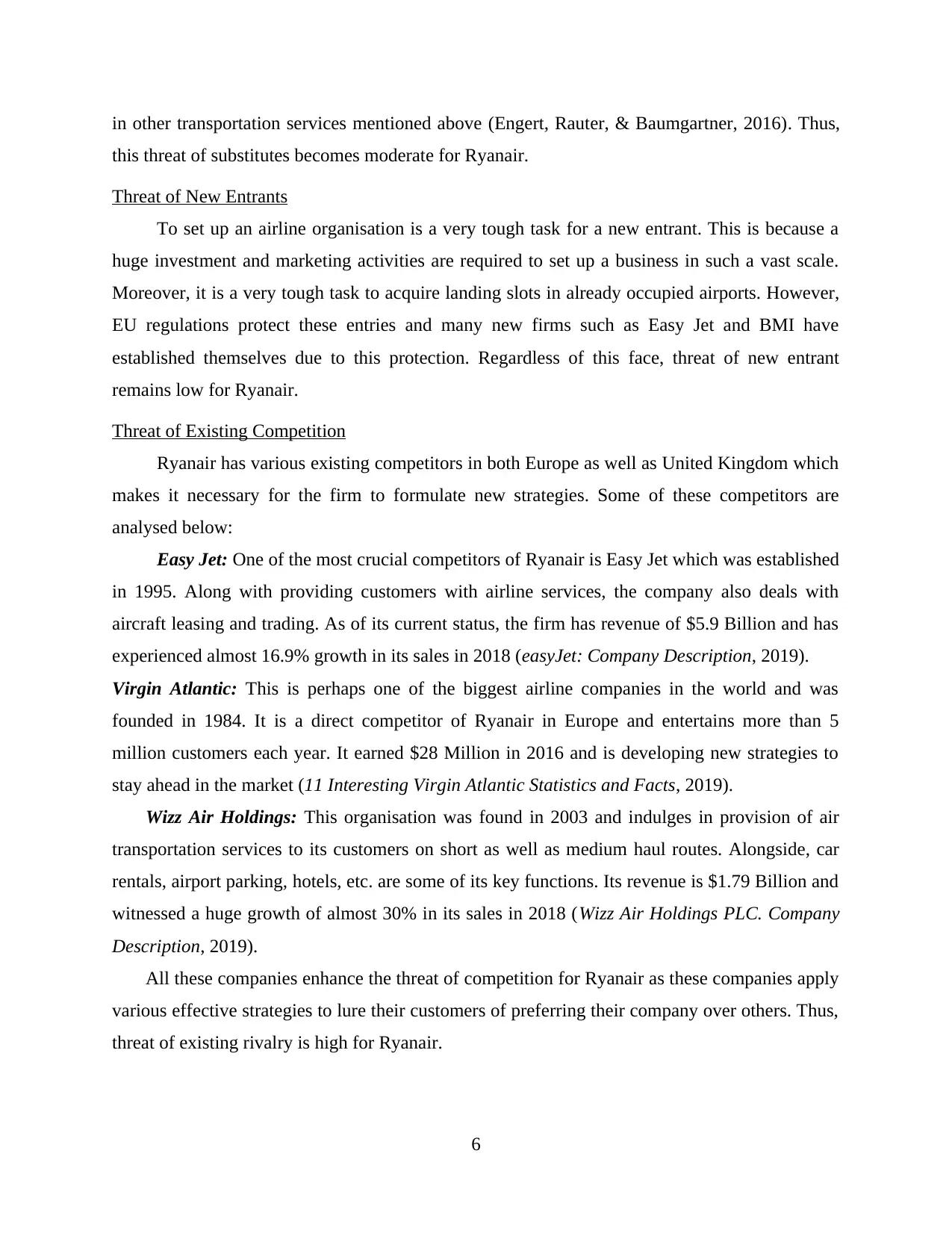
in other transportation services mentioned above (Engert, Rauter, & Baumgartner, 2016). Thus,
this threat of substitutes becomes moderate for Ryanair.
Threat of New Entrants
To set up an airline organisation is a very tough task for a new entrant. This is because a
huge investment and marketing activities are required to set up a business in such a vast scale.
Moreover, it is a very tough task to acquire landing slots in already occupied airports. However,
EU regulations protect these entries and many new firms such as Easy Jet and BMI have
established themselves due to this protection. Regardless of this face, threat of new entrant
remains low for Ryanair.
Threat of Existing Competition
Ryanair has various existing competitors in both Europe as well as United Kingdom which
makes it necessary for the firm to formulate new strategies. Some of these competitors are
analysed below:
Easy Jet: One of the most crucial competitors of Ryanair is Easy Jet which was established
in 1995. Along with providing customers with airline services, the company also deals with
aircraft leasing and trading. As of its current status, the firm has revenue of $5.9 Billion and has
experienced almost 16.9% growth in its sales in 2018 (easyJet: Company Description, 2019).
Virgin Atlantic: This is perhaps one of the biggest airline companies in the world and was
founded in 1984. It is a direct competitor of Ryanair in Europe and entertains more than 5
million customers each year. It earned $28 Million in 2016 and is developing new strategies to
stay ahead in the market (11 Interesting Virgin Atlantic Statistics and Facts, 2019).
Wizz Air Holdings: This organisation was found in 2003 and indulges in provision of air
transportation services to its customers on short as well as medium haul routes. Alongside, car
rentals, airport parking, hotels, etc. are some of its key functions. Its revenue is $1.79 Billion and
witnessed a huge growth of almost 30% in its sales in 2018 (Wizz Air Holdings PLC. Company
Description, 2019).
All these companies enhance the threat of competition for Ryanair as these companies apply
various effective strategies to lure their customers of preferring their company over others. Thus,
threat of existing rivalry is high for Ryanair.
6
this threat of substitutes becomes moderate for Ryanair.
Threat of New Entrants
To set up an airline organisation is a very tough task for a new entrant. This is because a
huge investment and marketing activities are required to set up a business in such a vast scale.
Moreover, it is a very tough task to acquire landing slots in already occupied airports. However,
EU regulations protect these entries and many new firms such as Easy Jet and BMI have
established themselves due to this protection. Regardless of this face, threat of new entrant
remains low for Ryanair.
Threat of Existing Competition
Ryanair has various existing competitors in both Europe as well as United Kingdom which
makes it necessary for the firm to formulate new strategies. Some of these competitors are
analysed below:
Easy Jet: One of the most crucial competitors of Ryanair is Easy Jet which was established
in 1995. Along with providing customers with airline services, the company also deals with
aircraft leasing and trading. As of its current status, the firm has revenue of $5.9 Billion and has
experienced almost 16.9% growth in its sales in 2018 (easyJet: Company Description, 2019).
Virgin Atlantic: This is perhaps one of the biggest airline companies in the world and was
founded in 1984. It is a direct competitor of Ryanair in Europe and entertains more than 5
million customers each year. It earned $28 Million in 2016 and is developing new strategies to
stay ahead in the market (11 Interesting Virgin Atlantic Statistics and Facts, 2019).
Wizz Air Holdings: This organisation was found in 2003 and indulges in provision of air
transportation services to its customers on short as well as medium haul routes. Alongside, car
rentals, airport parking, hotels, etc. are some of its key functions. Its revenue is $1.79 Billion and
witnessed a huge growth of almost 30% in its sales in 2018 (Wizz Air Holdings PLC. Company
Description, 2019).
All these companies enhance the threat of competition for Ryanair as these companies apply
various effective strategies to lure their customers of preferring their company over others. Thus,
threat of existing rivalry is high for Ryanair.
6
⊘ This is a preview!⊘
Do you want full access?
Subscribe today to unlock all pages.

Trusted by 1+ million students worldwide
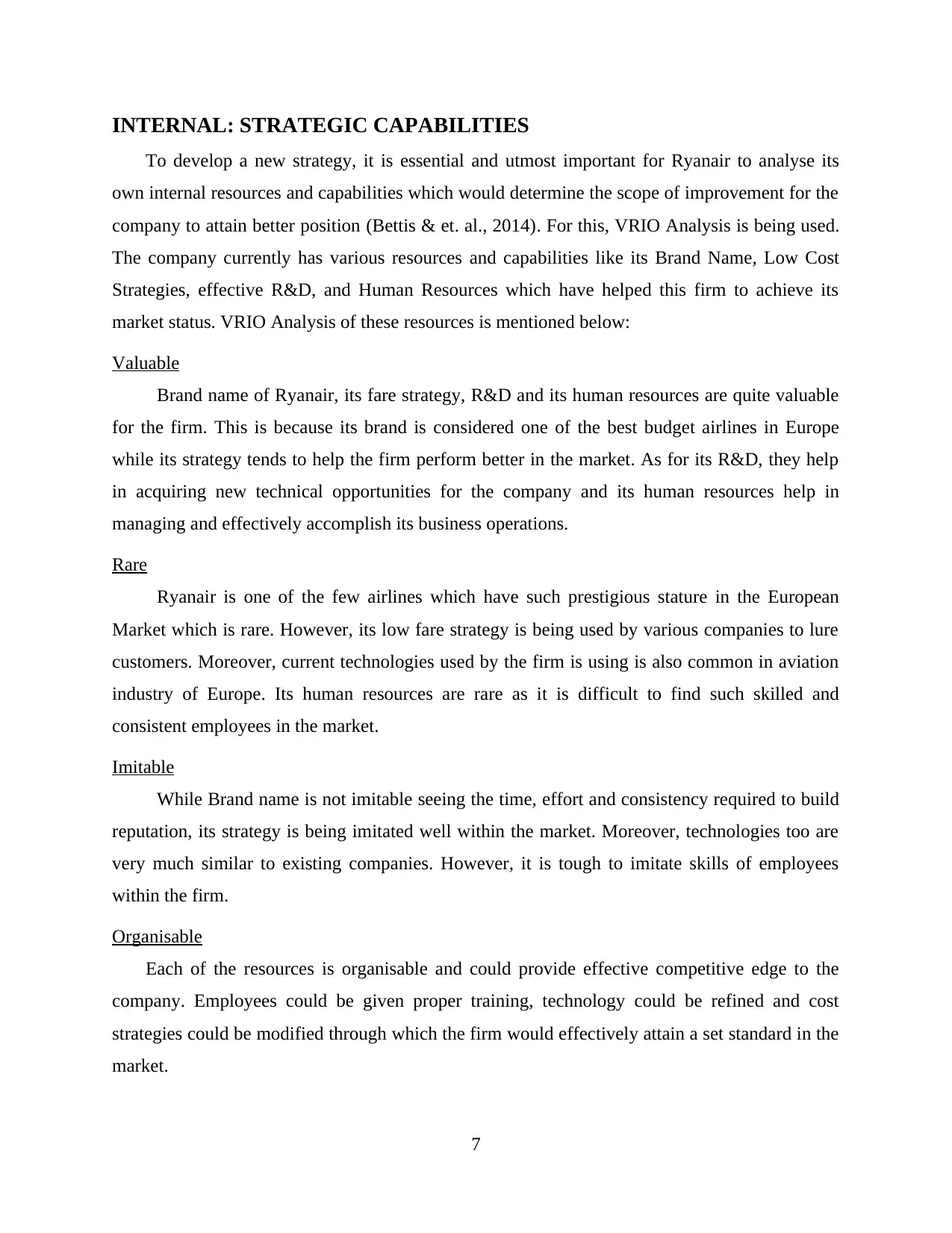
INTERNAL: STRATEGIC CAPABILITIES
To develop a new strategy, it is essential and utmost important for Ryanair to analyse its
own internal resources and capabilities which would determine the scope of improvement for the
company to attain better position (Bettis & et. al., 2014). For this, VRIO Analysis is being used.
The company currently has various resources and capabilities like its Brand Name, Low Cost
Strategies, effective R&D, and Human Resources which have helped this firm to achieve its
market status. VRIO Analysis of these resources is mentioned below:
Valuable
Brand name of Ryanair, its fare strategy, R&D and its human resources are quite valuable
for the firm. This is because its brand is considered one of the best budget airlines in Europe
while its strategy tends to help the firm perform better in the market. As for its R&D, they help
in acquiring new technical opportunities for the company and its human resources help in
managing and effectively accomplish its business operations.
Rare
Ryanair is one of the few airlines which have such prestigious stature in the European
Market which is rare. However, its low fare strategy is being used by various companies to lure
customers. Moreover, current technologies used by the firm is using is also common in aviation
industry of Europe. Its human resources are rare as it is difficult to find such skilled and
consistent employees in the market.
Imitable
While Brand name is not imitable seeing the time, effort and consistency required to build
reputation, its strategy is being imitated well within the market. Moreover, technologies too are
very much similar to existing companies. However, it is tough to imitate skills of employees
within the firm.
Organisable
Each of the resources is organisable and could provide effective competitive edge to the
company. Employees could be given proper training, technology could be refined and cost
strategies could be modified through which the firm would effectively attain a set standard in the
market.
7
To develop a new strategy, it is essential and utmost important for Ryanair to analyse its
own internal resources and capabilities which would determine the scope of improvement for the
company to attain better position (Bettis & et. al., 2014). For this, VRIO Analysis is being used.
The company currently has various resources and capabilities like its Brand Name, Low Cost
Strategies, effective R&D, and Human Resources which have helped this firm to achieve its
market status. VRIO Analysis of these resources is mentioned below:
Valuable
Brand name of Ryanair, its fare strategy, R&D and its human resources are quite valuable
for the firm. This is because its brand is considered one of the best budget airlines in Europe
while its strategy tends to help the firm perform better in the market. As for its R&D, they help
in acquiring new technical opportunities for the company and its human resources help in
managing and effectively accomplish its business operations.
Rare
Ryanair is one of the few airlines which have such prestigious stature in the European
Market which is rare. However, its low fare strategy is being used by various companies to lure
customers. Moreover, current technologies used by the firm is using is also common in aviation
industry of Europe. Its human resources are rare as it is difficult to find such skilled and
consistent employees in the market.
Imitable
While Brand name is not imitable seeing the time, effort and consistency required to build
reputation, its strategy is being imitated well within the market. Moreover, technologies too are
very much similar to existing companies. However, it is tough to imitate skills of employees
within the firm.
Organisable
Each of the resources is organisable and could provide effective competitive edge to the
company. Employees could be given proper training, technology could be refined and cost
strategies could be modified through which the firm would effectively attain a set standard in the
market.
7
Paraphrase This Document
Need a fresh take? Get an instant paraphrase of this document with our AI Paraphraser
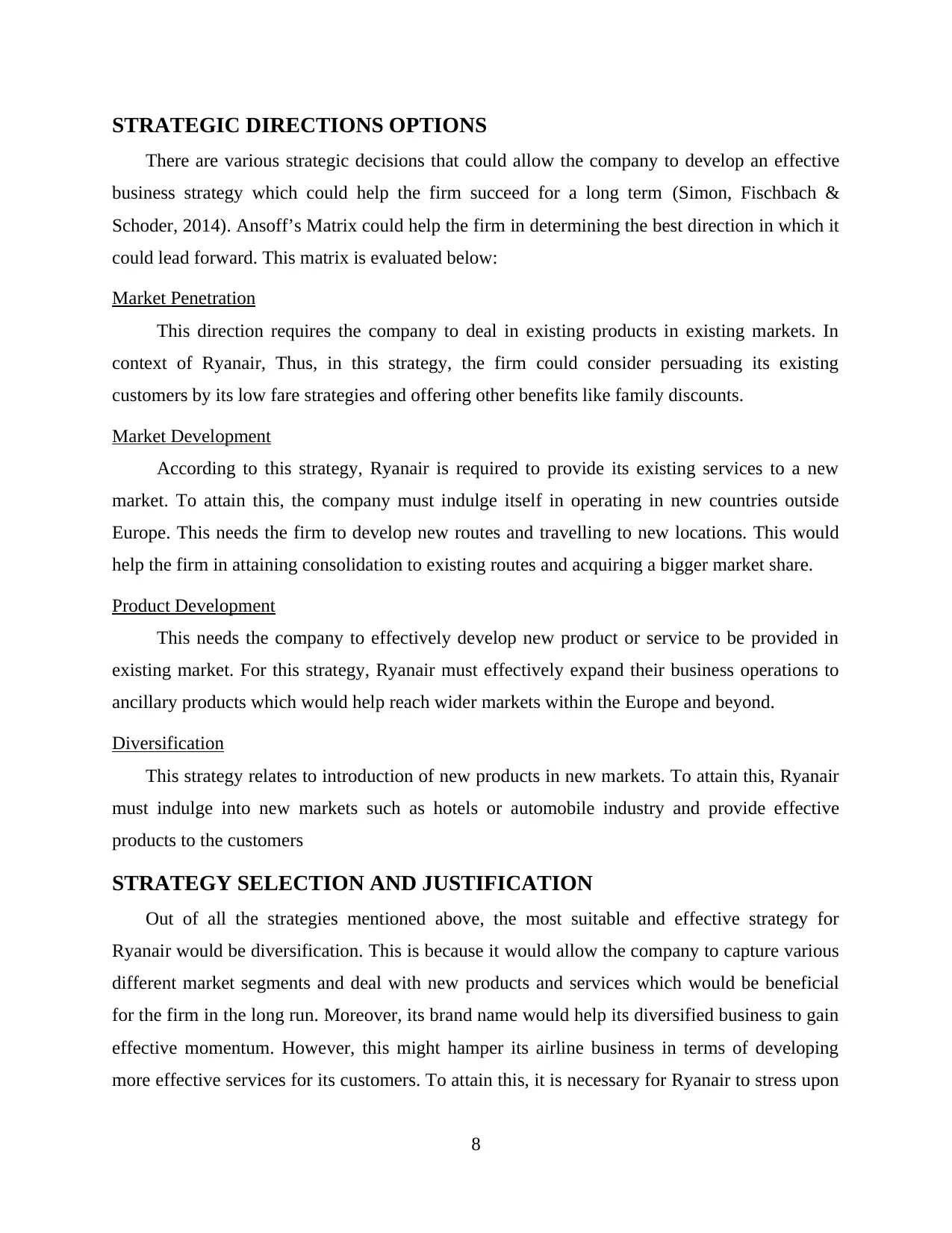
STRATEGIC DIRECTIONS OPTIONS
There are various strategic decisions that could allow the company to develop an effective
business strategy which could help the firm succeed for a long term (Simon, Fischbach &
Schoder, 2014). Ansoff’s Matrix could help the firm in determining the best direction in which it
could lead forward. This matrix is evaluated below:
Market Penetration
This direction requires the company to deal in existing products in existing markets. In
context of Ryanair, Thus, in this strategy, the firm could consider persuading its existing
customers by its low fare strategies and offering other benefits like family discounts.
Market Development
According to this strategy, Ryanair is required to provide its existing services to a new
market. To attain this, the company must indulge itself in operating in new countries outside
Europe. This needs the firm to develop new routes and travelling to new locations. This would
help the firm in attaining consolidation to existing routes and acquiring a bigger market share.
Product Development
This needs the company to effectively develop new product or service to be provided in
existing market. For this strategy, Ryanair must effectively expand their business operations to
ancillary products which would help reach wider markets within the Europe and beyond.
Diversification
This strategy relates to introduction of new products in new markets. To attain this, Ryanair
must indulge into new markets such as hotels or automobile industry and provide effective
products to the customers
STRATEGY SELECTION AND JUSTIFICATION
Out of all the strategies mentioned above, the most suitable and effective strategy for
Ryanair would be diversification. This is because it would allow the company to capture various
different market segments and deal with new products and services which would be beneficial
for the firm in the long run. Moreover, its brand name would help its diversified business to gain
effective momentum. However, this might hamper its airline business in terms of developing
more effective services for its customers. To attain this, it is necessary for Ryanair to stress upon
8
There are various strategic decisions that could allow the company to develop an effective
business strategy which could help the firm succeed for a long term (Simon, Fischbach &
Schoder, 2014). Ansoff’s Matrix could help the firm in determining the best direction in which it
could lead forward. This matrix is evaluated below:
Market Penetration
This direction requires the company to deal in existing products in existing markets. In
context of Ryanair, Thus, in this strategy, the firm could consider persuading its existing
customers by its low fare strategies and offering other benefits like family discounts.
Market Development
According to this strategy, Ryanair is required to provide its existing services to a new
market. To attain this, the company must indulge itself in operating in new countries outside
Europe. This needs the firm to develop new routes and travelling to new locations. This would
help the firm in attaining consolidation to existing routes and acquiring a bigger market share.
Product Development
This needs the company to effectively develop new product or service to be provided in
existing market. For this strategy, Ryanair must effectively expand their business operations to
ancillary products which would help reach wider markets within the Europe and beyond.
Diversification
This strategy relates to introduction of new products in new markets. To attain this, Ryanair
must indulge into new markets such as hotels or automobile industry and provide effective
products to the customers
STRATEGY SELECTION AND JUSTIFICATION
Out of all the strategies mentioned above, the most suitable and effective strategy for
Ryanair would be diversification. This is because it would allow the company to capture various
different market segments and deal with new products and services which would be beneficial
for the firm in the long run. Moreover, its brand name would help its diversified business to gain
effective momentum. However, this might hamper its airline business in terms of developing
more effective services for its customers. To attain this, it is necessary for Ryanair to stress upon
8
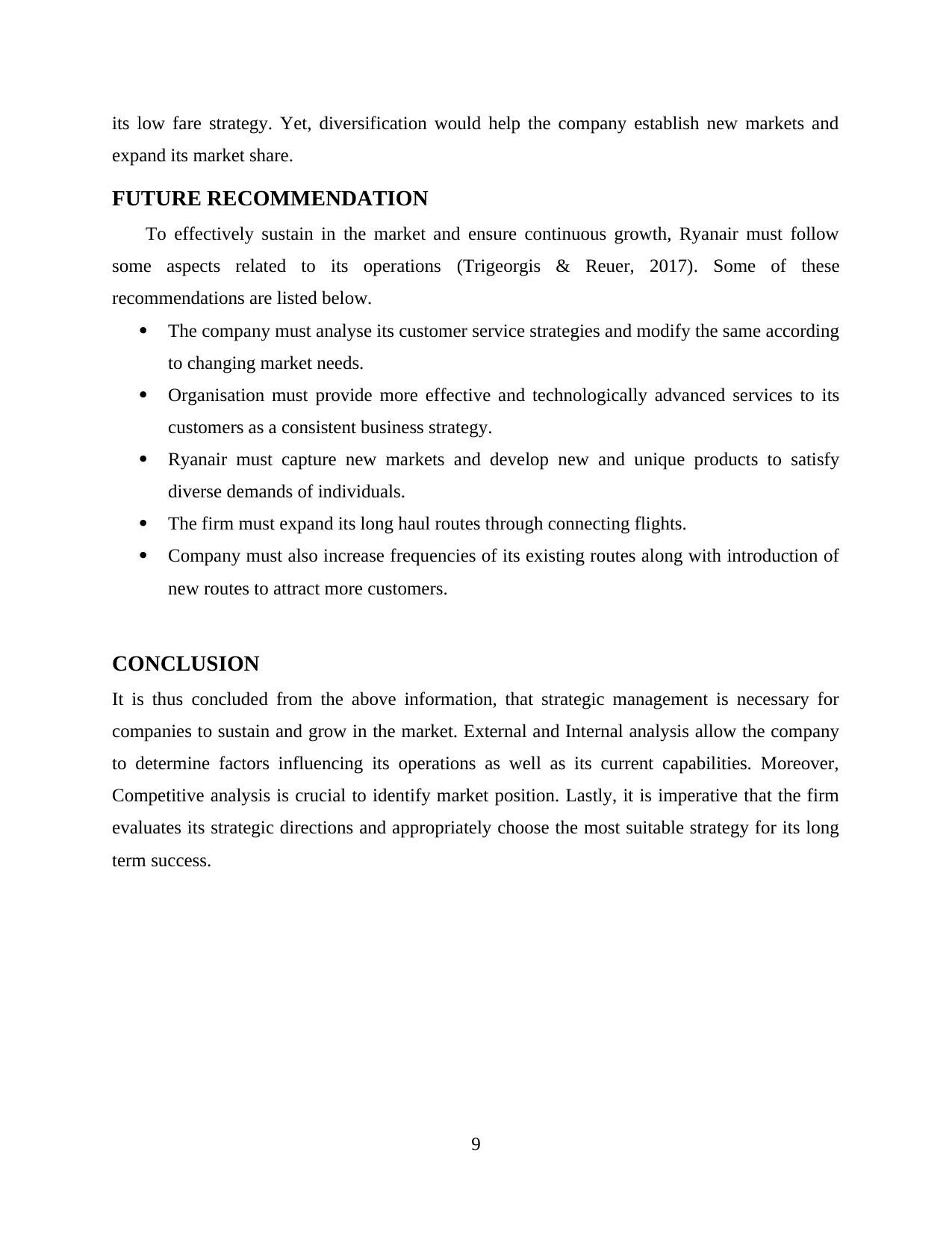
its low fare strategy. Yet, diversification would help the company establish new markets and
expand its market share.
FUTURE RECOMMENDATION
To effectively sustain in the market and ensure continuous growth, Ryanair must follow
some aspects related to its operations (Trigeorgis & Reuer, 2017). Some of these
recommendations are listed below.
The company must analyse its customer service strategies and modify the same according
to changing market needs.
Organisation must provide more effective and technologically advanced services to its
customers as a consistent business strategy.
Ryanair must capture new markets and develop new and unique products to satisfy
diverse demands of individuals.
The firm must expand its long haul routes through connecting flights.
Company must also increase frequencies of its existing routes along with introduction of
new routes to attract more customers.
CONCLUSION
It is thus concluded from the above information, that strategic management is necessary for
companies to sustain and grow in the market. External and Internal analysis allow the company
to determine factors influencing its operations as well as its current capabilities. Moreover,
Competitive analysis is crucial to identify market position. Lastly, it is imperative that the firm
evaluates its strategic directions and appropriately choose the most suitable strategy for its long
term success.
9
expand its market share.
FUTURE RECOMMENDATION
To effectively sustain in the market and ensure continuous growth, Ryanair must follow
some aspects related to its operations (Trigeorgis & Reuer, 2017). Some of these
recommendations are listed below.
The company must analyse its customer service strategies and modify the same according
to changing market needs.
Organisation must provide more effective and technologically advanced services to its
customers as a consistent business strategy.
Ryanair must capture new markets and develop new and unique products to satisfy
diverse demands of individuals.
The firm must expand its long haul routes through connecting flights.
Company must also increase frequencies of its existing routes along with introduction of
new routes to attract more customers.
CONCLUSION
It is thus concluded from the above information, that strategic management is necessary for
companies to sustain and grow in the market. External and Internal analysis allow the company
to determine factors influencing its operations as well as its current capabilities. Moreover,
Competitive analysis is crucial to identify market position. Lastly, it is imperative that the firm
evaluates its strategic directions and appropriately choose the most suitable strategy for its long
term success.
9
⊘ This is a preview!⊘
Do you want full access?
Subscribe today to unlock all pages.

Trusted by 1+ million students worldwide
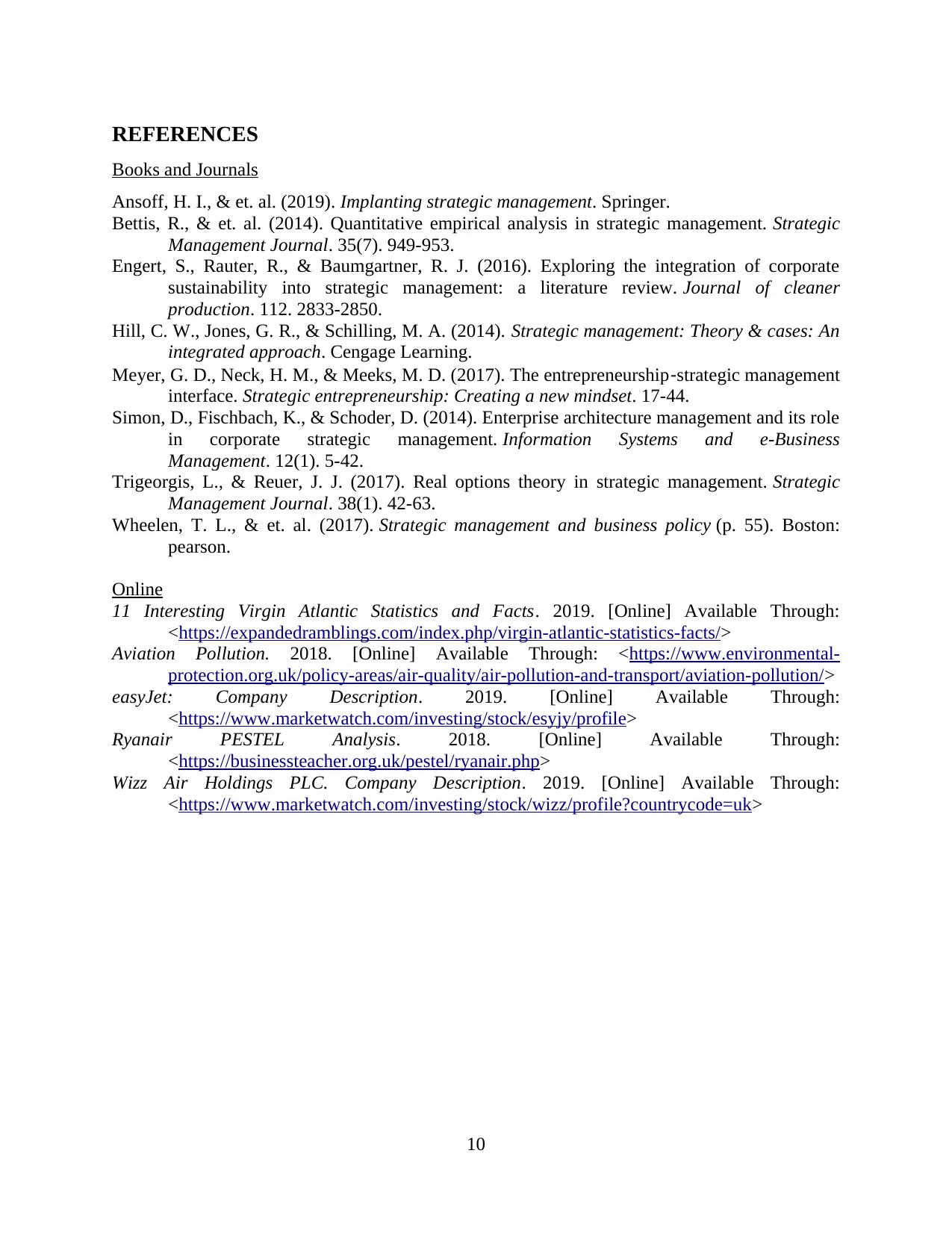
REFERENCES
Books and Journals
Ansoff, H. I., & et. al. (2019). Implanting strategic management. Springer.
Bettis, R., & et. al. (2014). Quantitative empirical analysis in strategic management. Strategic
Management Journal. 35(7). 949-953.
Engert, S., Rauter, R., & Baumgartner, R. J. (2016). Exploring the integration of corporate
sustainability into strategic management: a literature review. Journal of cleaner
production. 112. 2833-2850.
Hill, C. W., Jones, G. R., & Schilling, M. A. (2014). Strategic management: Theory & cases: An
integrated approach. Cengage Learning.
Meyer, G. D., Neck, H. M., & Meeks, M. D. (2017). The entrepreneurship‐strategic management
interface. Strategic entrepreneurship: Creating a new mindset. 17-44.
Simon, D., Fischbach, K., & Schoder, D. (2014). Enterprise architecture management and its role
in corporate strategic management. Information Systems and e-Business
Management. 12(1). 5-42.
Trigeorgis, L., & Reuer, J. J. (2017). Real options theory in strategic management. Strategic
Management Journal. 38(1). 42-63.
Wheelen, T. L., & et. al. (2017). Strategic management and business policy (p. 55). Boston:
pearson.
Online
11 Interesting Virgin Atlantic Statistics and Facts. 2019. [Online] Available Through:
<https://expandedramblings.com/index.php/virgin-atlantic-statistics-facts/>
Aviation Pollution. 2018. [Online] Available Through: <https://www.environmental-
protection.org.uk/policy-areas/air-quality/air-pollution-and-transport/aviation-pollution/>
easyJet: Company Description. 2019. [Online] Available Through:
<https://www.marketwatch.com/investing/stock/esyjy/profile>
Ryanair PESTEL Analysis. 2018. [Online] Available Through:
<https://businessteacher.org.uk/pestel/ryanair.php>
Wizz Air Holdings PLC. Company Description. 2019. [Online] Available Through:
<https://www.marketwatch.com/investing/stock/wizz/profile?countrycode=uk>
10
Books and Journals
Ansoff, H. I., & et. al. (2019). Implanting strategic management. Springer.
Bettis, R., & et. al. (2014). Quantitative empirical analysis in strategic management. Strategic
Management Journal. 35(7). 949-953.
Engert, S., Rauter, R., & Baumgartner, R. J. (2016). Exploring the integration of corporate
sustainability into strategic management: a literature review. Journal of cleaner
production. 112. 2833-2850.
Hill, C. W., Jones, G. R., & Schilling, M. A. (2014). Strategic management: Theory & cases: An
integrated approach. Cengage Learning.
Meyer, G. D., Neck, H. M., & Meeks, M. D. (2017). The entrepreneurship‐strategic management
interface. Strategic entrepreneurship: Creating a new mindset. 17-44.
Simon, D., Fischbach, K., & Schoder, D. (2014). Enterprise architecture management and its role
in corporate strategic management. Information Systems and e-Business
Management. 12(1). 5-42.
Trigeorgis, L., & Reuer, J. J. (2017). Real options theory in strategic management. Strategic
Management Journal. 38(1). 42-63.
Wheelen, T. L., & et. al. (2017). Strategic management and business policy (p. 55). Boston:
pearson.
Online
11 Interesting Virgin Atlantic Statistics and Facts. 2019. [Online] Available Through:
<https://expandedramblings.com/index.php/virgin-atlantic-statistics-facts/>
Aviation Pollution. 2018. [Online] Available Through: <https://www.environmental-
protection.org.uk/policy-areas/air-quality/air-pollution-and-transport/aviation-pollution/>
easyJet: Company Description. 2019. [Online] Available Through:
<https://www.marketwatch.com/investing/stock/esyjy/profile>
Ryanair PESTEL Analysis. 2018. [Online] Available Through:
<https://businessteacher.org.uk/pestel/ryanair.php>
Wizz Air Holdings PLC. Company Description. 2019. [Online] Available Through:
<https://www.marketwatch.com/investing/stock/wizz/profile?countrycode=uk>
10
1 out of 10
Related Documents
Your All-in-One AI-Powered Toolkit for Academic Success.
+13062052269
info@desklib.com
Available 24*7 on WhatsApp / Email
![[object Object]](/_next/static/media/star-bottom.7253800d.svg)
Unlock your academic potential
Copyright © 2020–2025 A2Z Services. All Rights Reserved. Developed and managed by ZUCOL.





